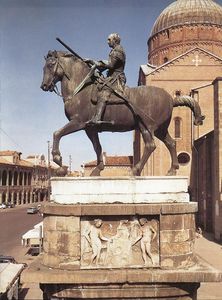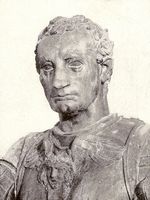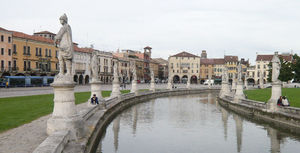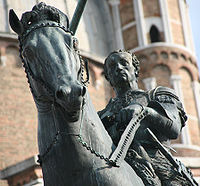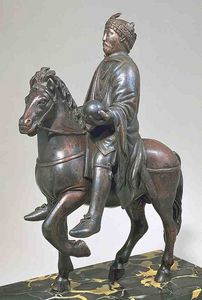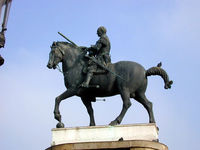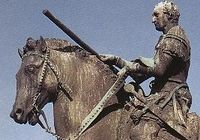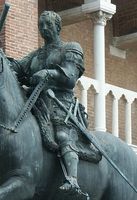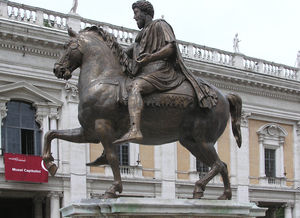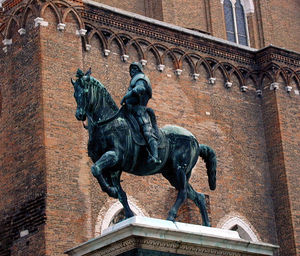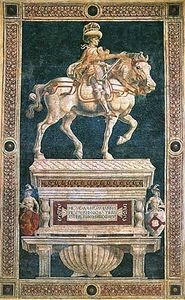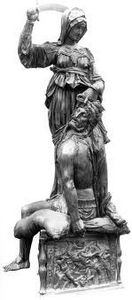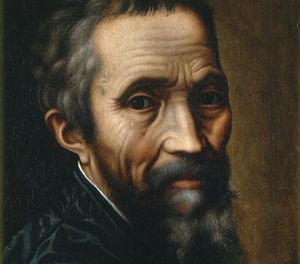Equestrian Statue of Gattamelata
- Date of Creation:
- 1453
- Medium:
- Other
- Subject:
- Figure
- Created By:
- Current Location:
- Padua, Italy
- Equestrian Statue of Gattamelata Page's Content
- Story / Theme
- Inspirations
- Analysis
- Critical Reception
- Related Sculptures
- Locations Through Time - Notable Sales
- Artist
- Art Period
- Bibliography
Equestrian Statue of Gattamelata Story / Theme
Erasmo da Narni, the subject of Donatello's Gattamelata, was a powerful and illustrious Venetian nobleman and condottiere (mercenary). His military victories were well-known throughout the Italian city-states of the Pre-Renaissance period and his family was well respected.
Da Narni died in 1443 and soon afterwards, his family commissioned the Gattamelata to commemorate da Narni's military prowess and fame.
Donatello began work immediately on the statue and finished it ten years later in 1453. It remains today where it was placed upon its completion, in the Piazza del Santo in Padua, Italy.
The Gattamelata was famous at the time for its departure from traditional equestrian statue subjects. Previous equestrian statues had been reserved exclusively for kings and other rulers.
Donatello's work is also a remarkable example of the fusion of Renaissance humanism and individualism with classicism. The statue sits on a pedestal and is itself nearly four meters high, life-size and majestic.
Da Narni died in his seventies but Donatello sculpted him as he was in his prime - powerful and dignified astride his horse. He did not bother to make the statue larger than life, as in the case of the classical equestrian statue of Marcus Aurelius (see Related Sculptures below); instead, Donatello manipulated the posture, facial expression and position to communicate da Narni's importance and grandeur.
The Gattamelata is considered one of Donatello's most important and groundbreaking works for both its subject matter and composition. Donatello sculpted the Gattamelata using the lost wax method, which was standard at the time for bronze statues, but he incorporated an individualism and emotional quality with which other sculptors had yet to experiment. Furthermore, he relied on his own capacity for expression in his work rather than physical dimensions.
Equestrian Statue of Gattamelata Inspirations
The Gattamelata was a commissioned piece of work for which Donatello no doubt received clear instructions and guidelines. However, evidence of Donatello's personal style is unmistakable in the composition and expressiveness of the Gattamelata.
Donatello drew on both the humanism and individualism of the Renaissance as well as elements of classicism to complete the magnificent Gattamelata. The artist crafted the Gattamelata as a tribute to both the military leader and the individualism so revered during the Renaissance. This work of art became the blueprint for equestrian monuments honoring military heroes.
Equestrian Statue of Gattamelata Analysis
Method:
The Gattamelata was groundbreaking in many ways. Though it was conceived in the typical lost wax method, from there Donatello's methods deviate markedly from the norm. Donatello's traditionally-meticulous attention to detail is obvious in all aspects of the Gattamelata, from the reliefs at the base of the pedestal to Erasmo da Narni's face.
Often compared to the oversized classic equestrian statue of Marcus Aurelius, the Gattamelata is nonetheless unique and, many scholars argue, far superior because of its reliance on emotion, composition, and symbolism - rather than sheer size - to communicate its subject's power and authority.
Composition:
The Gattamelata sits atop a pedestal 25 feet high; the statue itself is over 12 feet high. At the base of the pedestal are carved two reliefs, one featuring the da Narni coat of arms with two putti on either side, the other of angels clad in battle dress.
Moving upward, da Narni's horse is powerfully built and its youthful musculature well-defined, indicative of close study of equine anatomy. It appears to be trotting and is further evidence of Donatello's close adherence to the tenets of naturalism.
The horse's left hoof rests atop a sphere that represents the world, indicating that in his prime da Narni held Italy, and indeed the world, in the palm of his hand.
Da Narni himself is proud and stern-looking, staring unblinkingly ahead toward his goal. He is dressed for battle and carrying a sword. Da Narni was a serious military leader, followed and trusted by the fifteenth-century Italians - qualities which Donatello made obvious in his rendering of the famous condottiere.
Equestrian Statue of Gattamelata Critical Reception
There is no evidence suggesting that the Gattamelata was anything other than well received. It was commissioned by the famous and wealthy da Narni family of Padua and remains today where it was originally placed, in the Piazza del Santo.
The Gattamelata caused a slight stir when it was unveiled; up until that point in time equestrian monuments had been reserved for kings and other rulers or heads of state. Erasmo da Narni, the subject of the Gattamelata, was none of these. He was, rather, a Venetian condottiere, or mercenary, renowned throughout the Italian peninsula for his military genius.
However, despite the faint controversy caused by the statue, it came to be regarded as one of Donatello's most important works. It was extremely innovative for its time; its clever merging of classical elements with the naturalism of the Renaissance made it extraordinarily popular with other artists of the time and beyond.
Equestrian Statue of Gattamelata Related Sculptures
Equestrian Statue of Gattamelata Locations Through Time - Notable Sales
The Gattamelata was completed in 1453 and placed in the Piazza del Santo in Padua, Italy where it remains to this day.
Equestrian Statue of Gattamelata Artist
Donatello was a Florentine master who revolutionized sculpture during the Early Renaissance. He is best known for integrating elements of Classical art with that of the Renaissance (naturalism, humanism, and individualism).
The artist worked and lived alongside Italian masters such as Brunelleschi and Ghiberti and Gattamelata is among his most important contributions to the Renaissance.
Donatello was much in demand throughout his life by patrons and the church for his strikingly life-like and emotional works that seemed to have presence and personality of their own.
He maintained a lifelong friendship with the Medici family of Florence and worked extensively for them. He died in 1466 at the age of 80 after a long and extraordinarily prosperous career.
Equestrian Statue of Gattamelata Art Period
The Gattamelata was produced during the Early Renaissance, a period characterized by the art world's shaky transition out of the staid and largely unimaginative traditions of Gothicism.
The Early Renaissance saw the first masters of the time experiment with color, perspective, tone, subject matter and many other aspects of their work. For the first time artists were able to explore subject matter unrelated to religion.
Donatello was one of the leading innovators of the Early Renaissance; he is credited with having bridged the gap between the Renaissance and the Classic world by harmoniously incorporating elements of both into his sculptures. He also produced some of the first freestanding, life-size sculptures in a time when most artists were still focusing on reliefs.
The Early Renaissance paved the way for the High Renaissance and great masters such as Michelangelo, da Vinci and Raphael to name but a few.
Equestrian Statue of Gattamelata Bibliography
To learn more about Donatello please choose from the following recommended sources.
• Bennett, Bonnie A. & Wilkins, David G. Donatello. Moyer Bell Limited, 1985
• Janson, H. W. Sculpture of Donatello. Princeton University Press, 1979
• Lightbown, R. W. Donatello and Michelozzo: Artistic Partnership and Its Patrons in the Early Renaissance. Harvey Miller Publishers, 1980
• Lubbock, Jules. Storytelling in Christian Art from Giotto to Donatello. Yale University Press, 2006
• Poeschke, Joachim. Donatello and His World: Sculpture of the Italian Renaissance. Harry N Abrams, 1993
• Pope-Hennessy, John Wyndham. Donatello: Sculptor. Abbeville Press, 1993
• Rea, Hope. Donatello. Forgotten Books, 2010
• Scott, Leader. Ghiberti and Donatello: With Other Early Italian Sculptors. Bibliolife, 2008

